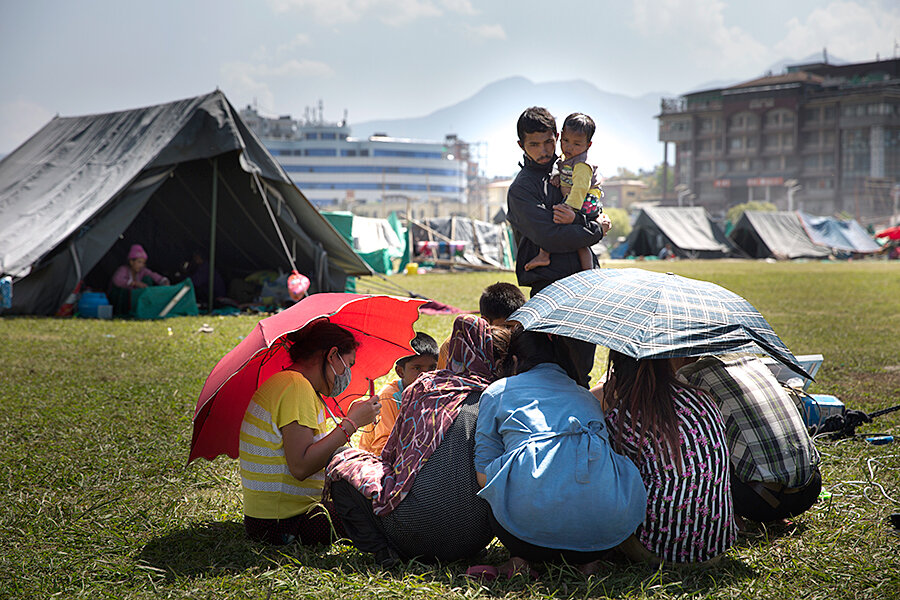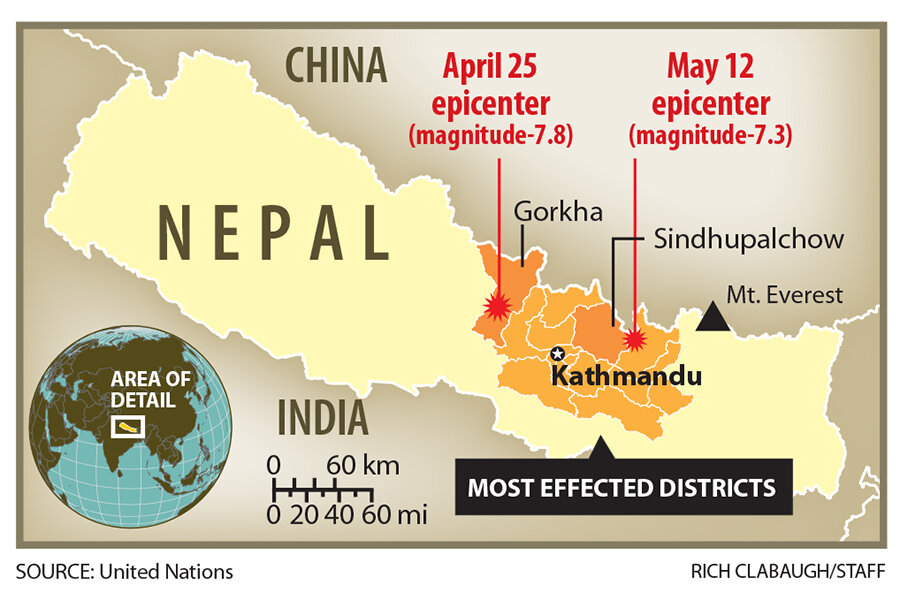Nepal quake: As monsoon hits, foreign donors pledge $4.4 billion in aid
Loading...
| Sindhupalchowk district, Nepal
Two months after Nepal’s deadliest quake on record, people in this mountainous region about 100 miles northeast of Kathmandu say it is no longer the jolting aftershocks but the steady monsoon rains that present the biggest challenge.
With 90 percent of houses in ruins, Sindhupalchowk is the worst-hit district in Nepal – even though the epicenter of the quake was relatively far away, in Gorkha district. Of the nearly 9,000 quake deaths in Nepal, 3,535 were suffered here.
Added to the crisis, more than a third of the heaviest aftershocks from the April 25 quake occurred here, including a magnitude- 7 jolt on May 12 that claimed many lives among those just starting to adjust.
But now, in a region with so many structures damaged or razed, the homeless say the often pelting rains are the problem, and they are trying to shift from tents and tarps to corrugated steel shelters.
“We no longer run for safety when an aftershock hits. It is rain that worries us,” says Maya Budhathoki, a young resident of Chautara town. “We have a tent provided by an NGO. It doesn’t have proper ventilation so it’s impossible to stay inside at daytime when the heat is scorching. With this kind of heat and heavy rain, the tent will not last."
Meanwhile in Kathmandu, exactly two months after the initial quake, more than 50 foreign nations and donor agencies at a one-day conference today pledged over $4.4 billion dollars to help Nepal recover. Authorities have put the estimated cost of recovery at $6.6 billion dollars.
Sindhupalchowk, with a population of 300,000, is topologically a cluster of hills and mountains. Most of its houses were built on steep slopes lining the district’s narrow and winding roads that are now replete with sights of destruction.
“Shelter, not food, remains the main problem,” says Bharat Acharya, deputy government chief of the district. “The tents and tarps now need to be replaced by stronger structures of wood and corrugated sheets to withstand strong winds and rain.”
Sheets and nails
Mr. Acharya’s office has so far distributed $7 million to affected families in the district, with each family getting about $130 for buying corrugated sheets and nails. “Our records show that 80,000 families in the district lost their homes in the quakes, so the total distributed sum will rise to [$12 million dollars] in coming weeks,” he adds.
After their home collapsed in the April 25 quake, Sagana Shrestha and her family were living in tents but realized that was not sustainable as information spread that relief and aid delivery were inefficient and delayed, and as the rains came.
After the giant May 12 aftershock, she says, “We pulled out wood beams from our collapsed house to build this shelter,” pointing to a sturdy-looking temporary house with walls made of wood and bamboo and roofed with corrugated iron sheets. The one-room house now serves as kitchen, dining, and bedroom for eight family members.
After the quake, the cost of building skyrocketed and Ms. Shrestha’s family used their own skills to build the house. But they spent $130 on corrugated sheeting.
“We will have to pay rent for using this land,” she says. “Once the tilting houses behind our damaged house are demolished, we will demolish our house and move this shelter to our land,” she says.
Frank questions about transparency
Shrestha’s father took up a factory job in Malaysia eight months ago, but hasn’t been able to send any cash to the family so far. Her elder sister, who works as a dentist’s assistant in a local town, is the only person providing financial help to the family.
“We need a proper house,” Shrestha says, but estimates the cost at $20,000 to $25,000 dollars.
At today’s donor’s conference, the proceeding shifted between monetary pledges and frank questions about transparency and accountability.
India, which enjoys considerable influence in Nepal, pledged a billion dollars. China pledged $483 million; Japan, $260 million; the United States $130 million; the United Kingdom, $120 million, and the European Union, $112 million. The Asian Development Bank and the World Bank Group pledged $600 million and $500 million respectively.
When the subject of accountability was raised, Nepalese Prime Minister Sushil Koirala vowed transparency: “I assure you that we will leave no stone unturned in ensuring that your support reaches the intended beneficiaries,” he said.
Nepalese authorities estimate a five year recovery from the quake’s devastation. Nepal's finance minister Ram Sharan Mahat said the work will start in mid-July.








